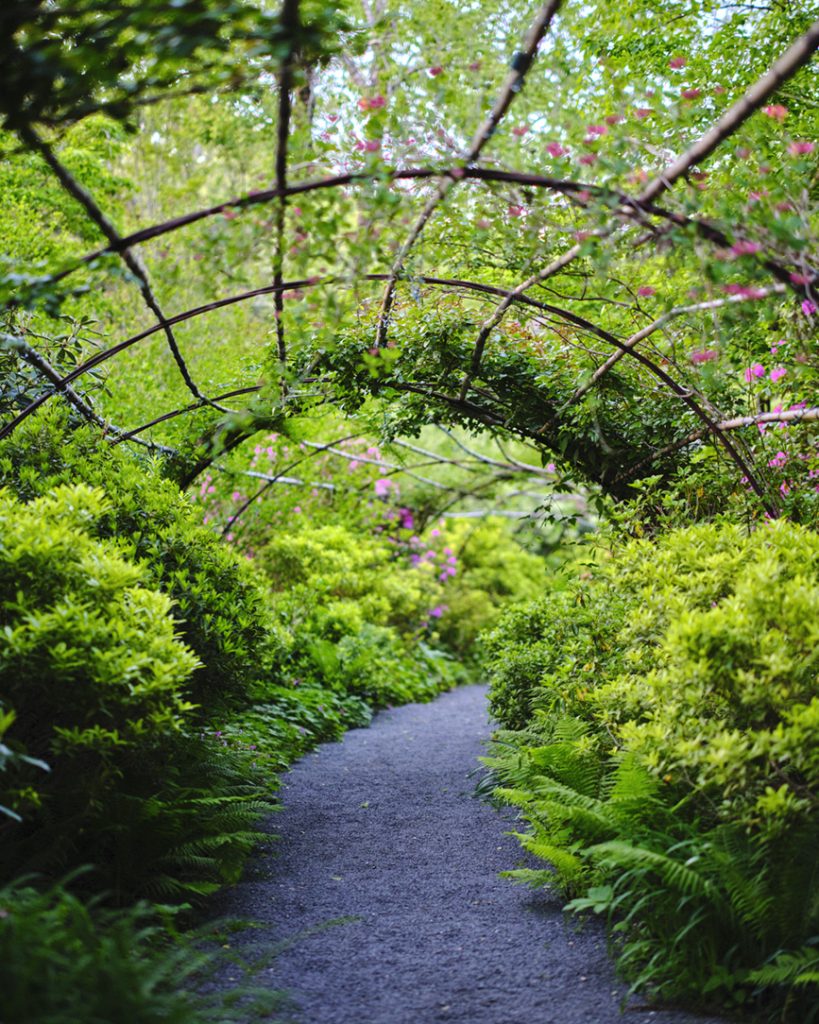A rolling, emerald-green lawn as short and soft as velvet; trees and privet clipped into tidy balls and squares; row upon rainbowed row of exotic cutting flowers: this may sound like the very picture of a classically beautiful garden, but sustainable landscape designer and environmental activist Edwina von Gal makes clear that these are also the makings of a harmful greenspace. “Our definition of perfection is toxic, and is gobbling up resources,” says von Gal, who for the past 20 years has worked from her home in East Hampton advocating for what she calls “nature-based” landcare and gardening, a minimally invasive style that promotes at least 70 percent native plants and eschews pesticides and excessive manicuring, yielding not only enchantingly wild, unbridled terrains, but also plots that allow native birds, bees, and humans to thrive in harmony. It’s an approach that has won her a devoted following—from artist Cindy Sherman to actor Robert de Niro, art dealer David Zwirner, and designer and sculptor Maya Lin—and a hand in a larger movement towards less controlled standards of beauty in gardening.
When von Gal, 74, started her namesake firm in 1984, she was guilty of perpetuating the very aesthetic she now lobbies against. “I was designing English-style gardens, because that’s what people were asking for, the more exotic and fussier the better, and I was doing whatever it took to keep them alive,” she says. “I learned over time that the more you try to control a landscape, the more resources and chemicals it takes, and the more harm it does.” In response to this problem, she founded Perfect Earth Project in 2013, a non-profit organization aimed at educating professional landscapers and home gardeners on how to create sustainable greenspaces, and also to appreciate—and perpetuate—the aesthetic that is born from these practices. That means prizing hearty native plants and pollinator fields of imperfect wildflowers and tall tangled grasses over endless expanses of groomed Kentucky bluegrass, delicate foreign blooms, and over-pruned trees that require an endless cycle of pesticides, watering, mulching, and fossil fuel–burning blowers and mowers just to survive—otherwise known as “the world of noise and poison,” says von Gal. “If we can change the desired aesthetic for gardens, we allow everyone to step into a world of joy and wonder, where nature is not an adversary but our partner.”
Von Gal selected eight gardens in the Hamptons that reflect her vision of a sustainable landscape. Some she designed herself. Others, she simply admires for their slight of human hand.
Public Use
A 16-acre natural sanctuary and sculpture garden in East Hampton, LongHouse Reserve is a non-profit estate founded by the textile artist Jack Lenor Larsen. The grounds have been designed by Larsen with practicality in mind, including a colorful array of low-maintenance flowering bushes such as rhododendron and azalea, an entirely pink garden with a rose-covered archway, and easy care ground-coverings like lily-of-the-valley and the purple-hued Japanese painted fern.
Meandering Design
Landscape architect Abby Lawless and von Gal greatly reduced the footprint of mowed lawn in this sprawling Wainscott estate to make room for a diverse array of ecosystems. Paths run through the entire property, which has several outbuildings, including a playhouse magically engulfed in Ostrich ferns, purple Dame’s Rocket, and climbing hydrangeas.
Native Habitat
Lawless designed this garden belonging to art dealer Gordon VeneKlasen, in Springs. It is dotted with several shade and sun gardens that create a stunning but organic contrast. A grove of Wild Black Cherry trees provides a canopy for birdlife, and a new daisy meadow will soon fill in with a diverse assortment of native wildflowers.
Letting Go
This part formal, part wild, and all toxic-free garden with plantings designed by Lawless in East Hampton is an example of how two styles can co-exist in one landscape and amplify one another. More controlled elements, such as clipped privet and boxwood, act as a sharp backdrop for a meandering arbor of Winter King hawthorn trees, blanketed by alliums and ferns; meanwhile, a twisting Paperbark maple is anchored by an antique Willy Ghul birdbath.
Lawn Reduction
The garden belonging to the artist Cindy Sherman—next door to von Gal’s own home in Springs—used to be a simple stretch of mowed lawn. With von Gal’s guidance, the landscape is now mostly uncut, allowing tall native meadow grasses and other non-invasive species to grow. Around the pond, which Sherman and von Gal added to welcome birds, outbuildings including a root cellar and chicken coop punctuate the landscape.
Imaginative Re-use
In von Gal’s own garden in Springs, the fundamental principles of the Perfect Earth Project are on full display, centering around food, shelter, and water for the wildlife that co-exist on her land. A small handmade pond—lined with clay, not plastic—provides a respite for birds, turtles, frogs, and bees. Rather than importing stone for the pathways that snake through the property, she’s repurposed slices of old tree trunks.
Water Clarity

Linda James, chair of the EH Energy Sustainability Committee, struggled to grow anything behind her cottage, which rests on a steep bank that extends to Hook Pond in East Hampton. Von Gal advised James to stop mowing her lawn and, in time, her once-brown backyard became a verdant meadow with long native grasses that act as an absorbent buffer zone for runoff into the pond.
Wild Discipline

The Springs property of art curator David White and Anthony Gammardella is an example of what was originally a very formal and controlled garden that has since been set free. Under von Gal’s watchful eye, privet is left unclipped and trees unpruned; seedheads are left to self-sow; and some “approved weeds” are allowed to spring up for a wild but still softly structured effect.
This story and more appears in PALMER On the Road, available now.




















